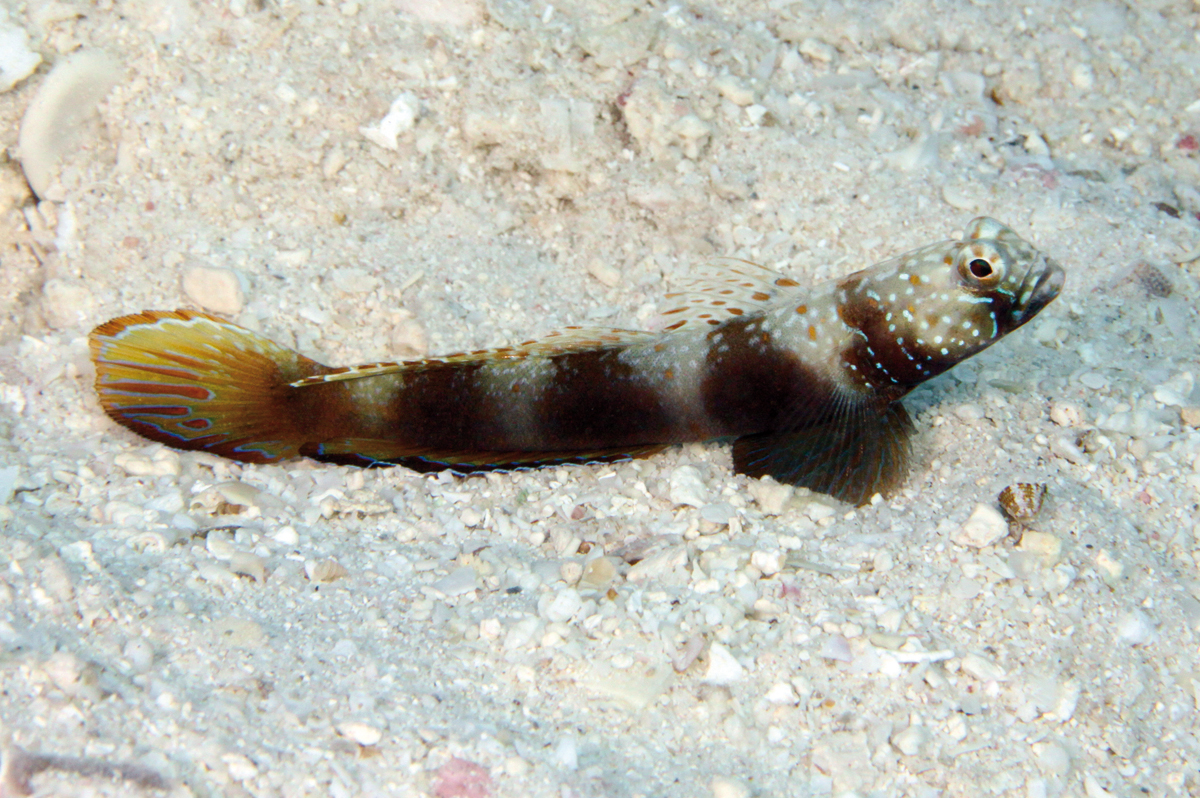- Classification
- ACTINOPTERYGII
- PERCIFORMES
- GOBIIDAE
- Amblyeleotris
- latifasciata
Wide-barred Shrimpgoby, Amblyeleotris latifasciata Polunin & Lubbock 1979

A Wide-barred Shrimpgoby, Amblyeleotris latifasciata, at Yardie Creek, Cape Range, Western Australia, August 2011. Source: Denise Jenkins / iNaturalist.org. License: CC by Attribution-NonCommercial
Summary:
A dark brown shrimpgoby with or without 3-4 broad dark bars along the side, bluish-white spots and bands on the head, and pale-edged red spots on the dorsal fins.
Cite this page as:
Bray, D.J. 2025, Amblyeleotris latifasciata in Fishes of Australia, accessed 27 Jun 2025, https://fishesofaustralia.net.au/Home/species/5636
Wide-barred Shrimpgoby, Amblyeleotris latifasciata Polunin & Lubbock 1979
More Info
|
Distribution |
Ningaloo Reef, Western Australia, inside Mangrove Sanctuary, depth 6 m. Elsewhere the species occurs in the Indo-west Pacific: Réunion (western Mascarenes) eastwards to Philippines, north to Thailand, south to Australia. Inhabits sand and coral-rubble areas on coastal to outer reef sand slopes, usually below 10 m. |
|
Features |
Dorsal fin VI + 1,13 (last ray divided to base); Anal fin I,13 (last ray divided to base); Pectoral fin 20; Pelvic fin I,5; Longitudinal scale series 87-92; Transverse scale series 29-30; Circumpeducular scales 25; Gill rakers on lower limb of first arch, including elongate raker at angle, 9-10 (all elements counted). Greatest depth of body 6.3-6.6 in SL; pelvic fins united by low membrane at base of fins; no median predorsal scales; caudal fin lanceolate, longer than head length. |
|
Biology |
Pairs live in association with burrowing alpheid shrimps. |
|
Etymology |
The specific name is from the Latin latus (= broad) and fasciatus (= banded) in reference to the "breadth of the bands on the body, which serve to distinguish this species from many related forms'. |
|
Species Citation |
Amblyeleotris latifasciata Polunin & Lubbock 1979, Bulletin of the British Museum (Natural History) Zoology 36(4): 247, Fig. 5. Type locality: Passage between Cabulan Island and Vandanon Island, Cebu Strait, Philippines, depth 15 m. |
|
Author |
Bray, D.J. 2025 |
|
Resources |
Wide-barred Shrimpgoby, Amblyeleotris latifasciata Polunin & Lubbock 1979
References
Allen, G.R. 1997. Marine Fishes of Tropical Australia and South-east Asia. Perth : Western Australian Museum 292 pp. 106 pls.
Allen, G.R. & Erdmann, M.V. 2012. Reef fishes of the East Indies. Perth : Tropical Reef Research 3 vols, 1260 pp.
Jaafar, Z. & Dexiang, C. 2014. Goby and shrimp associations: more than meets the eye. Coral Reefs 33(3): 863-863.
Karplus, I. 1987. The association between gobiid fishes and burrowing alpheid shrimp. Oceanogrphy and Marine Biology Annual Review 25(1): 507-562.
Kuiter R.H. & Tonozuka, T. 2001. Indonesian Reef Fishes. Part 3. Jawfishes - Sunfishes, Opistognathidae - Molidae. Melbourne : Zoonetics pp. 623–893.
Larson, H. 2021. Amblyeleotris latifasciata. The IUCN Red List of Threatened Species 2021: e.T170256727A170779400. https://dx.doi.org/10.2305/IUCN.UK.2021-1.RLTS.T170256727A170779400.en. Downloaded on 08 November 2021.
Larson, H.K. & Murdy, E.O. 2001. Eleotridae, Gobiidae. pp. 3574-3604 in Carpenter, K.E. & Niem, T.H. (eds). The Living Marine Resources of the Western Central Pacific. FAO Species Identification Guide for Fisheries Purposes. Rome : FAO Vol. 6 pp. 3381-4218.
Polunin, N.V.C. & Lubbock, R. 1979. Five new prawn-associated gobies (Teleostei: Gobiidae) of the genus Amblyeleotris. Bulletin of the British Museum (Natural History) Zoology 36(4): 239-249. See ref at BHL



